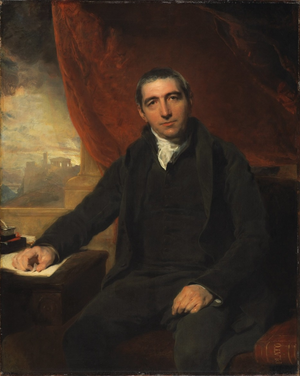Thomas Taylor (neoplatonist) facts for kids
Thomas Taylor (born May 15, 1758 – died November 1, 1835) was an English writer and thinker. He was the first person to translate all the works of the ancient Greek philosophers Plato and Aristotle into English. He also translated many other important ancient texts, including those from the Neoplatonist school of thought.
Contents
Thomas Taylor's Life
Thomas Taylor was born in London on May 15, 1758. His father, Joseph Taylor, was a staymaker. Thomas went to St. Paul's School where he loved studying classic subjects and mathematics.
He first worked as a clerk at a bank. Later, he became an Assistant Secretary for a group called the Society for the Encouragement of Art. This job helped him meet many important people. These friends helped him publish his many translations.
Taylor's goal was to translate all the ancient Greek philosophical writings that had not yet been put into English. Besides Plato and Aristotle, he translated works by Proclus, Porphyry, Apuleius, and others. These thinkers were part of the Neoplatonist and Pythagorean traditions.
His Love for Ancient Greece
Taylor deeply admired Hellenism, which is the culture and ideas of ancient Greece. He especially loved the ideas of Plato and the Neoplatonists like Proclus and Iamblichus. He translated their works into English. He loved ancient Greek so much that he and his wife would often speak to each other only in classical Greek.
Taylor also spoke out against what he saw as problems in the Christianity of his time. He believed it was not deep enough. Some people made fun of him and he made enemies. But many others respected his ideas. One of his friends was a unique traveler and philosopher named John "Walking" Stewart.
His Family Life
Thomas Taylor married his childhood sweetheart, Mary Morton, in 1777. They had several children together. Their children included George, John, William, Mary Joseph, and Thomas. Their oldest daughter, Mary Meredith Taylor, was named after a kind person who supported Taylor's work.
His first wife, Mary, passed away in 1809. He married again, and his second wife, Susannah, died in 1823. From his second marriage, he had one son named Thomas Proclus Taylor. Thomas Taylor himself passed away in Walworth.
How Thomas Taylor Influenced Others
The ancient texts Taylor used for his translations sometimes had missing parts. Taylor's deep understanding of the Platonists helped him suggest how to fill in these gaps. His translations were very important to famous writers like William Blake, Percy Bysshe Shelley, and William Wordsworth.
In America, his translations were read by thinkers such as Ralph Waldo Emerson and Bronson Alcott. They also influenced G. R. S. Mead, who worked with Helena Blavatsky of the Theosophical Society.
Taylor also wrote his own books about philosophy, especially about the Neoplatonism of Proclus and Iamblichus. He also wrote about mathematics. Many of these works have been printed again recently.
Taylor was inspired by ideas about human rights. He wrote a book called A Vindication of the Rights of Brutes. In this book, he argued that if people have rights, then animals should have rights too.
Some of Thomas Taylor's Works
Thomas Taylor wrote and translated many books. Here are a few examples of the types of works he created:
- Translations of Ancient Philosophers: He translated the complete works of Plato and Aristotle. He also translated many other important texts from thinkers like Proclus and Porphyry.
- Works on Ancient Mysteries: He wrote about ancient Greek religious practices, such as A Dissertation on the Eleusinian and Bacchic Mysteries.
- Original Philosophical Writings: He wrote his own books explaining Neoplatonism and other philosophical ideas, like The Creed of the Platonic Philosopher.
- Mathematical Works: He also wrote about mathematics, including The Elements of the true Arithmetic of Infinites.


